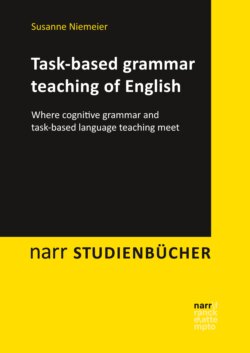Читать книгу Task-based grammar teaching of English - Susanne Niemeier - Страница 24
На сайте Литреса книга снята с продажи.
3.1.3 Categorization
ОглавлениеA further important notion in cognitive linguistics is categorization. Humans categorise everything they encounter, as this kind of mental organisation is a precondition for retrieval. The ability to categorise is present from early childhood onwards, although small children’s categories do not yet necessarily mirror those of adults. Children who have never seen a cow, but know horses, might lump the first cow that they encounter into the horse category, as these two types of animals have certain properties in common (a certain size, four legs etc.). When children grow older, they develop more fine-grained, adult-like categories. These categories are shaped by the language community’s social, cultural and linguistic input and are therefore resistant to change, although they are not completely unchangeable, as, for example, through scientific discoveries. However, quite frequently folk categories, i.e., non-expert categories, are kept up for a very long time. For example, although it is known today that the strawberry is actually a nut, most people still categorise it as a fruit.
These conceptual categories are reflected in language and in turn mirror cultural beliefs. As TYLER (2012: 47) puts it: “one would expect that speakers from different linguistic and cultural backgrounds will have somewhat different categories with different prototypes”. The category ‘animals’, for example, comprises all kinds of animals in the German (and British) culture – mammals, birds, reptiles, fish, insects and so on. In Australia, only mammals are ‘animals’, whereas the other groups are not called animals, but birds, reptiles, marsupials, fish or insects – there is no superordinate category. In the USA and in Canada, on the other hand, all these kinds are called ‘animals’ with the exception of insects, which are only called ‘insects’ and do not fall into the animal category. This goes to show that even in closely related cultures category membership can differ.
The probably best researched category in linguistics is that of colour. Although all humans have the same organs for colour perception, the number of basic colour terms varies between languages. Following the classic BERLIN/KAY research (1969), cultures have between two and eleven (later on changed to twelve1) basic colour terms, which in English are black, white, red, blue, green, yellow, brown, grey, purple, pink and orange. All other colour names are seen as non-basic. Cultures for which colours are not that important in their daily life and environment have developed fewer terms. For example, the language Dani (from Papua-New Guinea) possesses only two basic colour terms. The more basic colour terms exist in a language, the better the language users’ colour memory is assumed to be, as the different categories provide different labels which lets the language user conceptualise these colours as more different than if they fell under the same label. However, the linguistic evidence for this is somewhat inconclusive.
The best example of a category is called its prototype – it is the image that somebody would draw (if asked and if given the necessary artistic skills) if they heard the category name. The status of prototype usually differs between cultures. For example, in a Western culture a table would be drawn as being relatively high-legged, whereas the legs would be a lot shorter in the Japanese culture. Prototype status is related to the relative frequency with which the entity in question occurs in a culture and it can also change over time, as today’s prototypical car is different from the prototypical car of the 1950s, for example. The non-prototypical members of a category share some features with the prototype but differ more or less from it in other respects and are therefore called marginal (or peripheral) members of the category in question. They can also vacillate between two neighbouring categories because the borders between categories are normally not exactly determined but remain fuzzy, at least to a certain extent.
Thus, to quote colours again, the colour turquoise is grouped by some people into the ‘blue’ category whereas other people put it into the ‘green’ category. Such category vacillation could never happen to a prototype, as, for instance, nobody would ever put a prototypical ‘red’ into a different colour category than ‘red’. To use another example: a dog will always be put into the ‘mammal’ category, whereas some people, especially children, might put non-prototypical mammals, such as whales or bats, into the ‘fish’ respectively ‘bird’ categories because they share properties with prototypical fish or birds (whales can swim, bats can fly and so on).
Grammar also possesses categories and prototypes. According to LANGACKER (2008: 79), “grammatical elements of any sort are likely to be polysemous2, having a prototypical as well as an array of other, less central values”. Word classes, for example, can be seen as categories, and, again, every category has a prototype. A prototypical noun (such as ‘house’) has time stability, whereas a prototypical verb (such as ‘to run’) has no time stability. As in every category, there are also less prototypical, i.e., more marginal members. The nominal entity ‘lightning’, for example, has no time stability, as a lightning only lasts for fragments of a second, but since the word is a member of the noun category, it is perceived as object-like. On the other hand, the event ‘to know’ is normally quite time-stable, but since the expression is a member of the verb category, it is still perceived as rather event-like. In the same way, grammatical constructions have prototypical usages and less prototypical usages, which traditional grammars call ‘rules’ and ‘exceptions’, the latter ones normally having to be learnt by heart. In the cognitive-linguistic view, however, the non-prototypical usages can still be explained via the prototype as they share some of its meaning. When teaching, it is of utmost importance to start with the prototypes and to later on develop the non-prototypical usages on the basis of a firmly established prototype.
